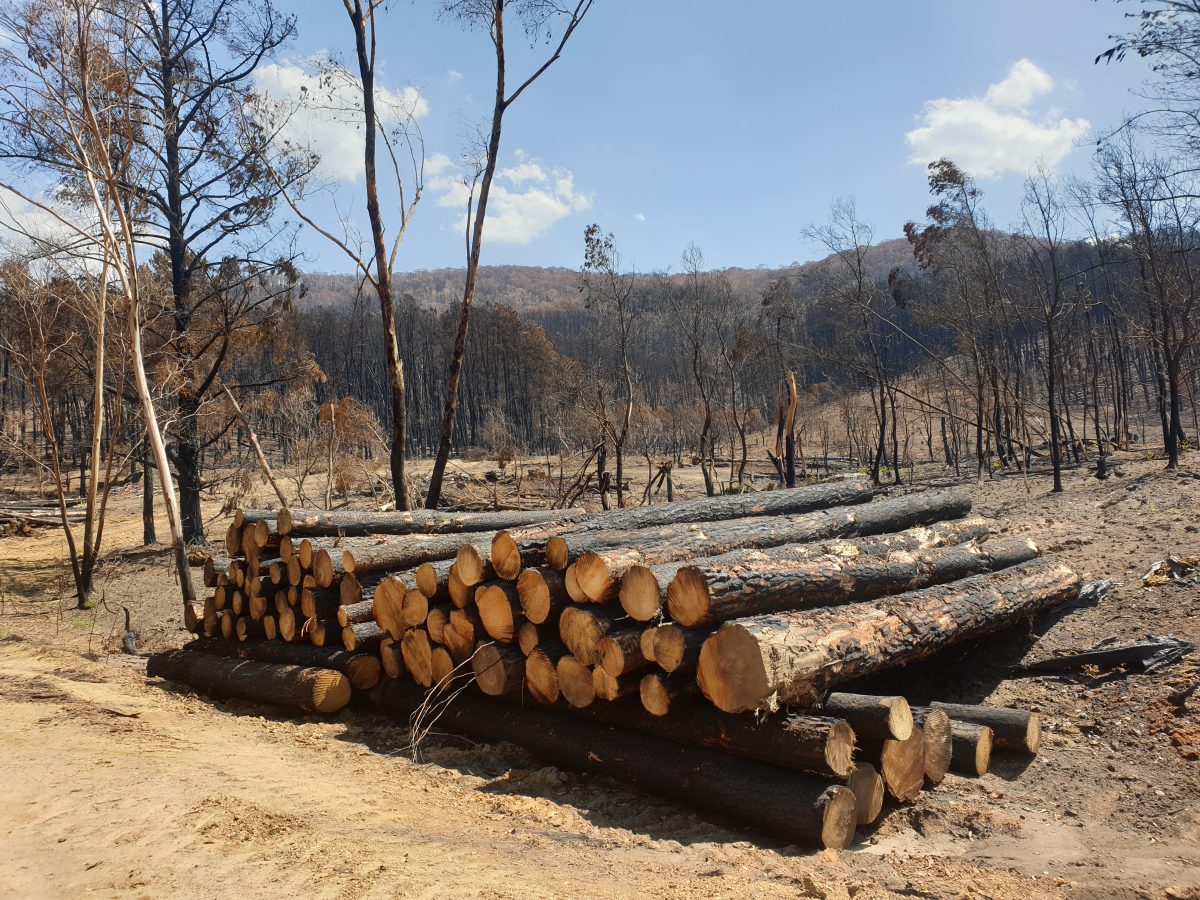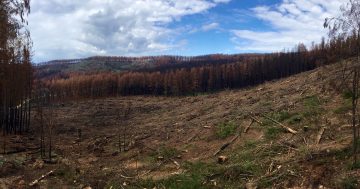
Lessons from past local bushfires informed actions to salvage timber from the charred forests in the Snowy Valleys after the Black Summer bushfires in the biggest ever industry salvage effort in Australia’s history. Image: Liz Fowler/Forestry Corporation.
Effective collaboration across the timber industry and learning the lessons from past fire salvage efforts have been highlighted as key factors underpinning the success of the record salvage program in the Tumut and Tumbarumba regions following the 2019-2020 Black Summer bushfires.
A report commissioned by Forestry Corporation of NSW summarising the challenges, successes and lessons from the timber salvage program in the Snowy Valleys has been shared with the industry to inform future fire recovery.
Forestry Corporation’s Sales and Procurement Manager Peter Stiles said the Black Summer fires were devastating for the local community, with the region’s softwood timber industry severely impacted and about 50 per cent of the pine plantations in the NSW South West Slopes burnt.
“Unlike many native species, pine trees die when they are burnt, but the industry was able to mobilise quickly and in numbers against the backdrop of the emerging COVID-19 pandemic to salvage a remarkable 2.7 million tonnes of timber in the two years following the fire,” he said.
Mr Stiles said this was the biggest ever salvage effort in Australia’s history and there was a lot to be proud of in what the industry achieved.
“The salvage program kept the lights on for our local processors immediately following the fires and created a boom in harvest and haulage work across the region, but importantly, it also maintained a quality supply of essential structural lumber and packaging products to the broader industry at a time of high demand,” he said.
Lessons from past fires underpinned the success of this salvage program, Mr Stiles explained.
“So while we hope fires like this will never be experienced again, it is important for us to share the lessons from the Black Summer salvage with the industry for the future.”
Report author, Damien O’Reilly from Mayday Hill Consulting, said the review made it clear collaboration across the timber supply chain was a key to the salvage program’s success.
“Forestry Corporation of NSW is a plantation manager that engages contractors to harvest timber and supply it to third party processors and close collaboration across the supply chain and with local and interstate forest growers was an essential ingredient in the salvage program’s success,” Mr O’Reilly said.
He said the timber industry as a whole shared the objective of maintaining a sustainable supply of timber not just for today but also for the future.
“So it worked to balance immediate and long-term timber needs in the decisions that were made following the fires,” Mr O’Reilly said.
The salvage program benefited from experiences in assessing damage and managing the processing of burnt timber learnt following past local fires such as the Billo Road fire in 2006 and Jananee fire in 2014, as well as invaluable advice and support from the industry across Victoria and South Australia, and through Forest and Wood Products Australia (FWPA).
“This salvage program demonstrated the effectiveness of remote sensing technology and estate modelling in prioritising salvage operations and informing processors, contractors and the community about the medium and long-term impacts on the resource,” Mr O’Reilly said.

The Snowy Valley’s softwood timber industry was severely impacted by the Black Summer bushfires of 2019-2020, with about 50 per cent of the pine plantations in the NSW South West Slopes burnt. Image: Liz Fowler/Forestry Corporation.
There was also significant investigation into log storage options under water or sprinklers, including a trial that provided useful lessons should long-term storage of burnt timber be required following fires in future.
Overwhelmingly, the report found collaboration with customers and contractors was a fundamental reason underpinning the success of the program.
Flexibility from customers, coordination of contractor capacity, and engagement with other growers enabled the industry to maximise the salvage of burnt timber and minimise the harvesting of unburnt timber to allow it to grow and deliver timber in future years.
The report specifically focused on the salvage of softwood timber from the Tumut and Tumbarumba regions and has been published on the Forestry Corporation website.
Several inquiries and inquests have looked into the 2019-20 fires and Forestry Corporation continues to work with the NSW Rural Fire Service and other government agencies to implement improvements recommended by those inquiries.











